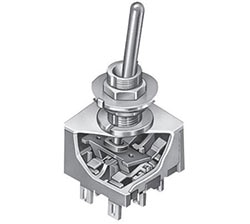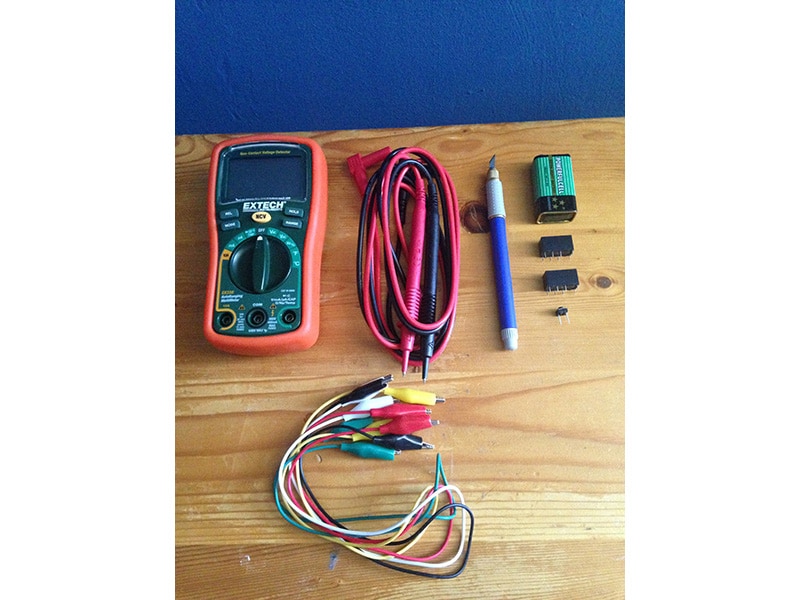切勿小瞧开关规格
 Figure 1: E-Switch’s PS1024ARED pushbutton switch. (Image source: E-Switch)
Figure 1: E-Switch’s PS1024ARED pushbutton switch. (Image source: E-Switch)
There are a lot of specifications to consider when looking for the perfect switch for your application. When specifying a switch, some of the most obvious factors include voltage and current ratings, normally open or closed, type of switch, number of poles and throws, and illuminated or non-illuminated, to name a few.
While a lot of these individual specifications are pretty straight forward, there are some that could trip you up if you’re not careful. Take, for example, switch voltage and current ratings. Be aware that there is a difference between AC and DC operating ratings and that switch manufacturers provide these different ratings most of the time. We’ll get into what to do when only the AC rating is specified for a switch you want to use in a DC application later.
It’s always a good idea to double check the manufacturer’s drawings or datasheets to make sure you get a switch suitable for your application. If they specify a 75 VAC voltage rating, this is obviously the AC voltage rating. However, if the specified voltage rating is listed as 75 V, then this is the DC voltage rating.
Another thing that could be confusing is that there are multiple ratings for some switches. Looking at the drawing for E-Switch’s PS1024ARED (Figure 1), for example, there are two listed ratings: 1.5 A at 250 VAC and 3 A at 125 VAC. With voltage times current equaling power, these ratings are more concerned with limiting the power to 375 Watts. In any case, 250 VAC is the maximum voltage rating for this switch regardless of the potential application current.
As mentioned earlier, many switches will only call out an AC rating in their datasheets. As luck would have it, there is a handy standardized rule of thumb to help in determining a DC rating for a switch with only an AC rating called out. Using this rule, the DC voltage rating is arbitrarily set to 30 V and the DC current rating is set at the maximum AC current rating found on the datasheet. Using the PS1024ARED switch again as an example, its drawing only specifies AC ratings. With 3 A listed as the maximum current rating, the DC rating would be 3 A at 30 V for this switch.
Another thing to pay attention to while searching for the right switch are the accessories that are available for that switch and if those accessories would be required or useful in the application you are designing the switch into. This is where the DigiKey website could prove to be very helpful. When looking at the product page for a given switch, any applicable accessories will be listed toward the bottom of the page. As an example, take the KB16CKW01-5F-JF from NKK Switches. There are four accessories related to this switch listed in the “Associated Product” section (Figure 2).
 Figure 2: The accessories associated with NKK Switches KB16CKW01-5F-JF pushbutton illuminated switch. (Image source: DigiKey)
Figure 2: The accessories associated with NKK Switches KB16CKW01-5F-JF pushbutton illuminated switch. (Image source: DigiKey)
Looking at Figure 2, some useful accessories associated with this switch are displayed. Taking these one at a time, the wrench socket could be very helpful when mounting this panel mount switch. Furthermore, this wrench is designed to work for all KB Series switches. Therefore, you only need one of these wrench sockets to mount any number of these switches and you could save it to use on future projects. To prevent accidental switch actuation, you could use the protective guard designed for this switch series that is also shown in Figure 2. Finally, the last two accessories shown are a cap extractor (that can be used with many different NKK switch series) and a replacement LED.
To sum things up, several factors can make finding the right switch difficult. Two of these are making sure that the correct voltage and current ratings are met and obtaining the additional accessories required. These are just a couple of the items that should be verified when choosing a switch.
Speaking of switches, DigiKey recently posted a short video on switch basics. This video is embedded below:

Have questions or comments? Continue the conversation on TechForum, Digi-Key's online community and technical resource.
Visit TechForum










